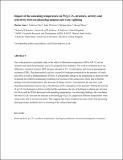Impact of the annealing temperature on Pt/g-C3N4 structure, activity and selectivity between photodegradation and water splitting
Abstract
This work presents a systematic study of the effect of fabrication temperature (450 to 650 °C) on the structure and electronic properties of g-C3N4 prepared from melamine. The work is conducted by X-ray diffraction, elemental analysis, BET nitrogen adsorption, UV–vis absorption, and electron paramagnetic resonance (EPR). The photocatalytic activity is tested for hydrogen production in the presence of oxalic acid (OA) as well as triethanolamine (TEOA). A considerable change in the morphology is observed with increasing the synthesis temperature resulting in an increase of the surface area, likely due to thermal etching. The decrease of charge carriers’ concentration, per unit surface area, with increasing annealing temperature may be due to the decrease of the conjugation of the polymer. Probing the activity of in situ reduced Pt/g-C3N4 for hydrogen evolution reinforced this conclusion, the rate of hydrogen evolution per unit area for OA as well as TEOA decreased with increasing annealing temperature. An interesting finding is the correlation between CO2:H2 ratio and the increase in the band gap of g-C3N4 prepared at different temperatures when using oxalic acid as an electron donor. This suggests that water oxidation becomes easier with increasing band gap energy, probably due to a lowering of the valence band edge.
Citation
Caux , M , Fina , F , Irvine , J T S , Idriss , H & Howe , R 2017 , ' Impact of the annealing temperature on Pt/g-C 3 N 4 structure, activity and selectivity between photodegradation and water splitting ' , Catalysis Today , vol. 287 , pp. 182-188 . https://doi.org/10.1016/j.cattod.2016.11.007
Publication
Catalysis Today
Status
Peer reviewed
ISSN
0920-5861Type
Journal article
Description
The authors would like to thank SABIC as well as EPSRC platform grant [EP/K015540/1] for financial support and the Royal Society of Chemistry for a Wolfson Merit Award. In order to protect intellectual property the data underpinning this publication are not made publicly available. All enquiries about the data should be addressed to mc253@st-andrews.ac.uk.Collections
Items in the St Andrews Research Repository are protected by copyright, with all rights reserved, unless otherwise indicated.

